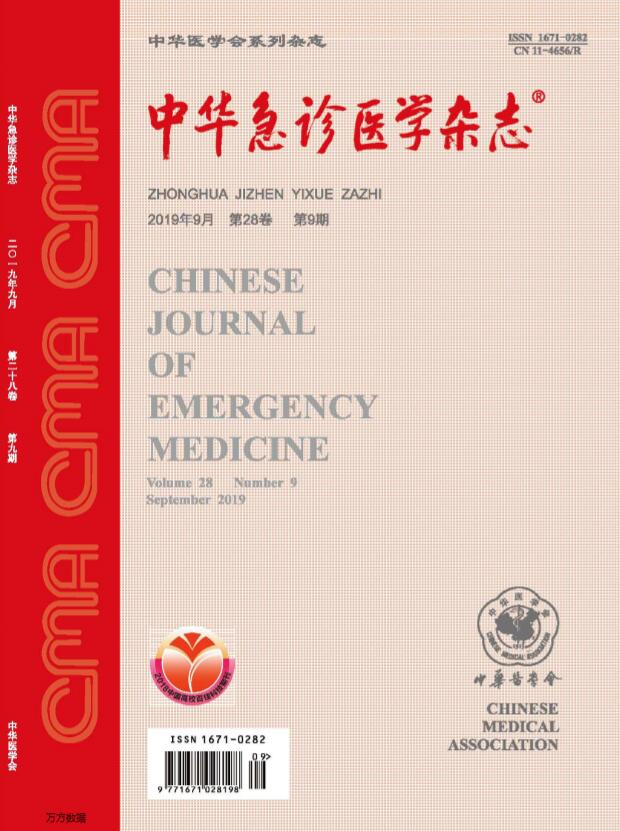感染性心肌病发病率及危险因素分析
Q4 Nursing
引用次数: 2
摘要
目的探讨感染性心肌病的发病率及危险因素,为感染性心肌病诊断、治疗和预防提供依据。方法2015年1月至2017年8月,吉林大学第一医院ICU收治208例感染性或感染性休克(≥18岁)患者。对所有患者的临床数据进行回顾性分析,并比较感染性心肌病组(39例)和非感染型心肌病组(169例)的基线数据和临床结果。采用多元Logistic回归分析方法分析感染性心肌病的危险因素。结果(1)感染性或感染性休克患者感染性心肌病的发生率约为18.8%。(2)基线体重、心房颤动、高血压、糖尿病、恶性肿瘤、最高体温、血白细胞、C反应蛋白(CRP)、降钙素原(PCT)、血培养阳性、,年龄(P=0.01)、性别(P=0.02)、心力衰竭史(P=0.03)、冠心病史(P=0.01,ICU住院时间(P=0.03)两组间差异有统计学意义。(3) 有心力衰竭病史(OR=1.55,95%CI:0.73-1.66;P=0.01)、有冠心病病史(OR=1.18,95%CI:1.03-1.66;P=0.03)和ICU入院乳酸>4.0 mmol/L(OR=1.10,95%CI:1.00-1.30;P=0.04)的患者是感染性心肌病发病率的独立危险因素。结论感染性心肌病在感染性或感染性休克患者中发病率较高。心力衰竭史、冠心病史和ICU入院时乳酸>4.0 mmol/L的患者是感染性心肌病发病率的独立危险因素。关键词:败血症性心肌病;发病率;风险因素;脓毒症;败血症休克本文章由计算机程序翻译,如有差异,请以英文原文为准。
Analysis of incidence and risk factors of septic cardiomyopathy
Objective
To investigate the incidence and risk factors of septic cardiomyopathy, and to provide evidence for the diagnosis, treatment and prevention of septic cardiomyopathy.
Methods
Totally 208 patients with septic or septic shock (≥18 years old) were admitted to ICU Department of The First Hospital of Jilin University from January 2015 to August 2017. The clinical data of all patients were retrospectively analyzed, and the baseline data and clinical outcomes were compared between the septic cardiomyopathy group (39 cases) and non-septic cardiomyopathy group (169 cases). Multiple Logistic regression analysis was used to analyze the risk factors of septic cardiomyopathy.
Results
(1) The incidence of septic cardiomyopathy in patients with septic or septic shock was about 18.8%. (2) There was no significant difference in baseline body weight, atrial fibrillation, hypertension, diabetes, malignant tumor, maximum body temperature, blood leukocyte, C-reactive protein(CRP), procalcitonin(PCT), positive blood culture, in-hospital mortality and 30-day mortality between the two groups (all P>0.05). Age (P=0.01), sex (P=0.02), history of heart failure (P=0.03), history of coronary heart disease (P=0.01), platelet at ICU admission (P=0.01), lactic acid at ICU admission (P=0.02), vasoactive drugs (P=0.03), APACHE Ⅱ score (P=0.03), SOFA score (P=0.01), and ICU length of hospital stay (P=0.03) were significantly different between the two groups. (3) Patients with a history of heart failure (OR=1.55, 95%CI:0.73-1.66; P=0.01), a history of coronary heart disease (OR=1.18, 95%CI: 1.03-1.66; P=0.03), and lactic acid at ICU admission > 4.0 mmol/L (OR=1.10, 95%CI: 1.00-1.30; P=0.04) were independent risk factors for the incidence of septic cardiomyopathy.
Conclusion
Septic cardiomyopathy has a relatively high incidence in patients with septic or septic shock. Patients with a history of heart failure, a history of coronary heart disease and lactic acid at ICU admission > 4.0 mmol/L are independent risk factors for the incidence of septic cardiomyopathy.
Key words:
Septic cardiomyopathy; Morbidity; Risk factors; Sepsis; Septic shock
求助全文
通过发布文献求助,成功后即可免费获取论文全文。
去求助
来源期刊

中华急诊医学杂志
Nursing-Emergency Nursing
CiteScore
0.10
自引率
0.00%
发文量
8629
期刊介绍:
Chinese Journal of Emergency Medicine is the only national journal which represents the development of emergency medicine in China. The journal is supervised by China Association of Science and Technology, sponsored by Chinese Medical Association, and co-sponsored by Zhejiang University. The journal publishes original research articles dealing with all aspects of clinical practice and research in emergency medicine. The columns include Pre-Hospital Rescue, Emergency Care, Trauma, Resuscitation, Poisoning, Disaster Medicine, Continuing Education, etc. It has a wide coverage in China, and builds up communication with Hong Kong, Macao, Taiwan and international emergency medicine circles.
 求助内容:
求助内容: 应助结果提醒方式:
应助结果提醒方式:


